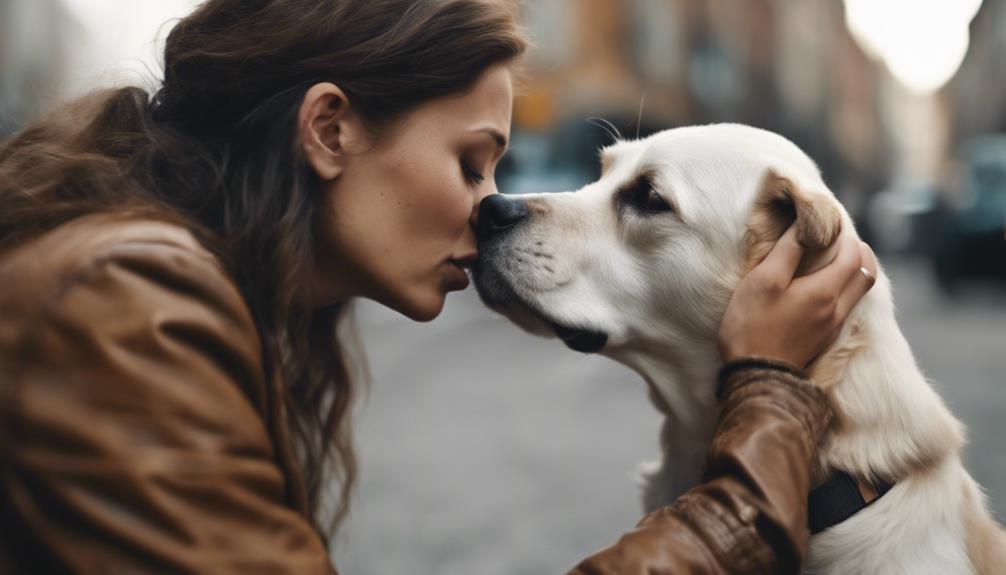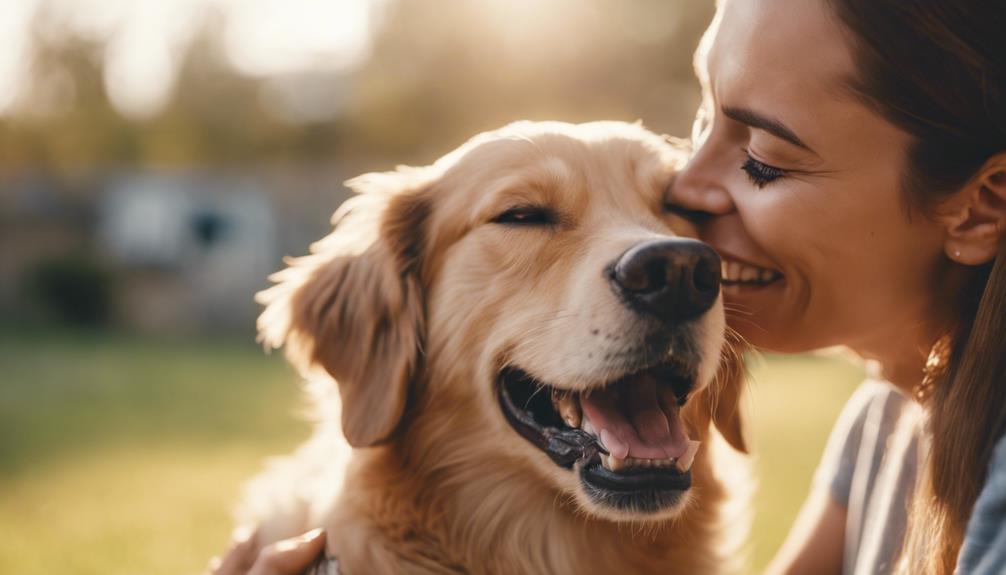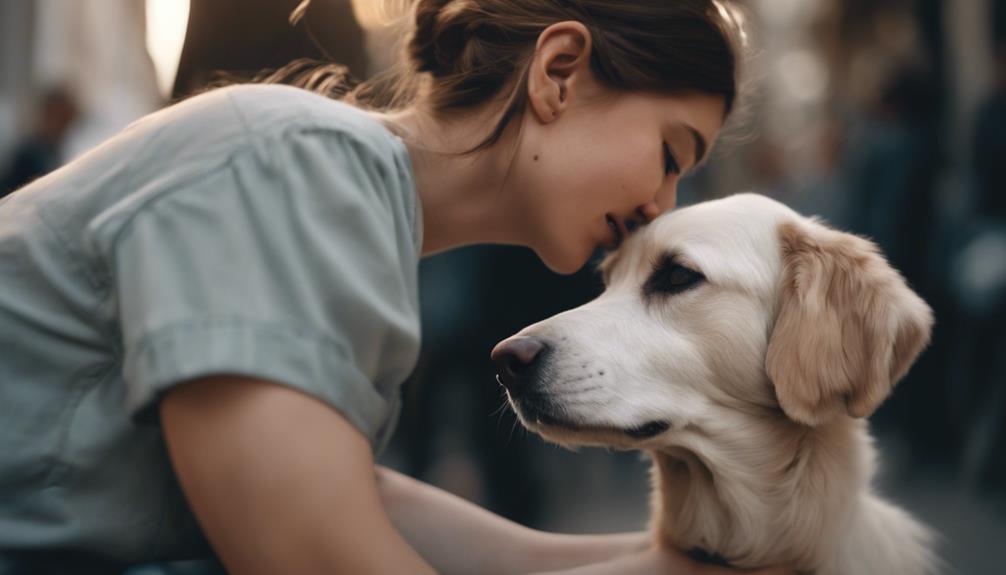As we ponder the age-old question of whether dogs truly appreciate our gestures of affection through kisses, a realm of fascinating insights awaits those curious about canine behavior.
The intricacies of how dogs interpret and respond to such displays of love offer a glimpse into the complex world of human-animal relationships. By exploring the subtle cues and signals that shape dogs' attitudes towards kisses, we may uncover a surprising truth that challenges conventional wisdom.
Stay tuned to unravel the mysteries behind dogs' reactions to this intimate form of interaction, shedding light on a topic that may hold more surprises than meets the eye.
Key Takeaways
- Dogs may enjoy kisses if taught their meaning positively.
- Kissing can cause stress if dogs don't understand.
- Dog licks can signal attention-seeking rather than affection.
- Yawning or sneezing may indicate discomfort or a desire for space.
Dogs' Understanding of Human Kisses
The comprehension of human kisses by dogs varies based on individual experiences and learned behaviors. Dogs, not naturally inclined to interpret kisses, may find them confusing or stressful if the meaning is unclear.
Some dogs can be taught to enjoy kisses as a form of affection, while others may exhibit appeasement signals like licking in response. Yawning and sneezing can also indicate discomfort or a desire for space when faced with unwanted kisses.
Understanding each dog's unique preferences and boundaries is crucial to building a positive relationship. By paying attention to body language cues and providing positive reinforcement, owners can help dogs navigate affectionate gestures effectively.
Professional guidance from animal behaviorists can offer further insights into enhancing dogs' responses to affection.
Dogs' Reactions to Kisses
Understanding how dogs react to kisses involves observing their body language and responses to determine their comfort level and preferences for affectionate gestures. Some dogs may enjoy kisses, while others may find them stressful or confusing.
Dogs might communicate their feelings through behaviors like yawning, licking, or sneezing, which can indicate discomfort or a desire for space. It's essential to respect individual dog preferences and boundaries to avoid causing distress.
Positive reinforcement can help dogs associate kisses with positive experiences, but it's crucial to be attentive to their cues and adjust your behavior accordingly. Consulting with a professional animal behaviorist can provide further insights into interpreting and responding to your dog's reactions to affectionate gestures.
Kisses as Stress Triggers for Dogs

Observing dogs' reactions to kisses can reveal how this form of affection may serve as a stress trigger for some canine companions.
- Body Language: Watch for signs of stress like lip licking, yawning, or averting their gaze during or after a kiss.
- Physical Reactions: Some dogs may tense up, back away, or even growl when kissed, indicating discomfort.
- Past Experiences: Dogs with negative associations or past trauma may find kisses distressing.
- Respect Boundaries: Always respect your dog's boundaries and cues to avoid overwhelming them with unwanted affection.
Dog Licks Vs. Human Kisses
Comparing the communicative significance of dog licks with human kisses reveals distinct behavioral cues and responses in canine companions. While human kisses are a form of affection and bonding, dog licks serve various purposes beyond displaying love.
Dogs often lick as a way to communicate submission, seek attention, or show appeasement. Unlike human kisses, which are more standardized in their meaning, dog licks can convey a range of messages depending on the context and the individual dog's personality.
Understanding the nuanced differences between these gestures can help pet owners interpret their dog's behaviors more accurately and strengthen their bond through appropriate responses to their furry friend's communication cues.
Canine Communication Through Yawning
Yawning in dogs serves as a subtle yet significant form of communication within their social interactions, conveying various messages related to their emotional state and level of comfort.
- Yawning can indicate stress or discomfort in dogs.
- It may serve as a signal to de-escalate a situation.
- Dogs often yawn to communicate a need for space.
- Understanding yawning in dogs can help improve interactions and prevent misunderstandings.
Appeasement Signals in Dogs
Signaling submission and diffusing tension, dogs express appeasement through a variety of nonverbal cues in their social interactions. These signals are crucial for maintaining harmony and avoiding conflicts in canine communication. Some common appeasement signals displayed by dogs include:
| Appeasement Signal | Description |
|---|---|
| Yawning | Indicates discomfort or a desire for space |
| Lip Licking | Demonstrates submission and pacifying behavior |
| Turning Head Away | Shows avoidance or a wish to de-escalate |
| Play Bow | Invites play and signals friendly intentions |
| Slow Approach | Indicates non-threatening behavior and respect |
Understanding and responding appropriately to these signals enhances communication with dogs and fosters positive interactions.
Positive Reinforcement for Dogs

Understanding and utilizing positive reinforcement techniques is paramount in fostering desired behaviors and strengthening the bond between dogs and their owners.
- Consistency: Rewarding good behavior promptly and consistently reinforces the behavior you want to see in your dog.
- Timing: Timing is crucial; reward your dog immediately after the desired behavior to reinforce the association between the action and the reward.
- Variety of Rewards: Use a variety of rewards such as treats, praise, toys, or extra playtime to keep your dog engaged and motivated.
- Patience and Persistence: Positive reinforcement takes time and repetition. Be patient and persistent in rewarding your dog for the behaviors you want to encourage.
Seeking Professional Advice for Dogs
Seeking professional guidance from a certified animal behaviorist can provide valuable insights and tailored strategies to address any concerns regarding your dog's behavior. These professionals have the expertise to assess your dog's reactions to affection and offer customized advice based on your dog's individual needs.
An animal behaviorist can help you understand the reasons behind your dog's responses, whether positive or negative, and guide you on how to foster a healthy relationship with your furry companion. By consulting with a professional, you can gain a better understanding of your dog's preferences, boundaries, and communication cues, ultimately enhancing the bond between you and your pet.
Don't hesitate to seek expert advice to ensure a harmonious and fulfilling relationship with your beloved canine companion.
Alternatives to Kissing Dogs

When considering alternatives to kissing dogs, it is important to explore various ways of showing affection that align with your canine companion's preferences and comfort level.
- Petting and Cuddling: Engage in gentle petting and cuddling sessions to express love and closeness.
- Verbal Affirmations: Speak to your dog in a soothing and loving tone to reassure them of your affection.
- Playtime: Discover your dog's favorite games and actively participate in play sessions to bond and have fun together.
- Interactive Toys: Provide stimulating toys and activities that entertain your dog and promote mental and physical engagement.
Showing Love Through Actions
Expressing love towards your canine companion can be effectively demonstrated through thoughtful and engaging actions. Actions such as petting, playing, and spending quality time with your dog can strengthen your bond and show affection. By understanding your dog's preferences and responding to their cues, you can create a loving and harmonious relationship. Below is a table highlighting some ways to show love through actions:
| Action | Description | Benefit |
|---|---|---|
| Petting | Gentle strokes and scratches to show affection | Promotes bonding and relaxation |
| Engaging in activities | Playing games or going for walks together | Increases physical and mental stimulation |
| Providing toys | Offering toys that engage and entertain your dog | Prevents boredom and encourages play |
Discovering Dog Preferences
Understanding the unique preferences of dogs is crucial for fostering a harmonious and fulfilling relationship with your canine companion. When exploring your dog's preferences:
- Observe Behavior Cues: Pay attention to how your dog reacts to different forms of affection to discern their preferences.
- Experiment with Affection: Try various ways of showing love, such as petting, cuddling, or playing, to see what resonates with your dog.
- Respect Individuality: Recognize that each dog is unique and may have specific likes and dislikes when it comes to affection.
- Seek Feedback: Look for signs of enjoyment or discomfort in your dog's responses to different displays of affection to tailor your interactions accordingly.
Respecting Dog Boundaries
Respecting the boundaries of your dog is essential for maintaining a healthy and trusting relationship with your canine companion.
Just like humans, dogs have their own preferences and comfort levels when it comes to affection and interactions. It is crucial to pay attention to your dog's body language and cues to understand when they may feel stressed, uncomfortable, or overwhelmed.
By respecting your dog's boundaries, you show them that you care about their well-being and build a stronger bond based on trust and mutual respect.
Creating a safe space where your dog feels understood and comfortable will contribute to a harmonious and fulfilling relationship between you and your furry friend.
Understanding Canine Body Language
Interpreting canine body language is crucial for effective communication and building trust with your dog. Understanding how dogs express themselves through their gestures and movements can facilitate a stronger bond between you and your furry companion. Here are four key aspects to consider when deciphering your dog's body language:
- Pay attention to tail position and movement, as it can indicate emotions like happiness, fear, or aggression.
- Observe ear position and facial expressions, which convey feelings such as alertness, relaxation, or stress.
- Take note of overall body posture, including stance and muscle tension, to gauge your dog's comfort level in different situations.
- Learn about vocalizations, such as barks and growls, which can reveal your dog's mood and intentions.
Insights Into Dog Behavior
For a deeper understanding of dogs' behavior patterns and responses, exploring their innate instincts and communication cues is essential. Here are some insights into dog behavior:
| Behavior Insight | Description | Example |
|---|---|---|
| Body Language | Dogs use body language to communicate emotions and intentions. | Tail wagging can indicate excitement or happiness. |
| Social Hierarchy | Dogs establish hierarchies within packs or households. | Dominant dogs may display assertive behaviors. |
| Vocalizations | Barks, growls, and whines are ways dogs express themselves. | A high-pitched bark can signal excitement. |
| Play Behavior | Play helps dogs learn social skills and bond with others. | Tug-of-war can be a form of play that strengthens bonds. |
Conclusion
In conclusion, the intricate dynamics of canine behavior reveal a complex interplay between dogs' responses to human affection, including kisses.
By delving into dogs' understanding of kisses, their reactions, stress triggers, and communication methods, we gain valuable insights into fostering positive interactions with our canine companions.
Respecting dog preferences and boundaries, while understanding their body language, is essential for strengthening the bond between humans and dogs through empathetic affection displays.




